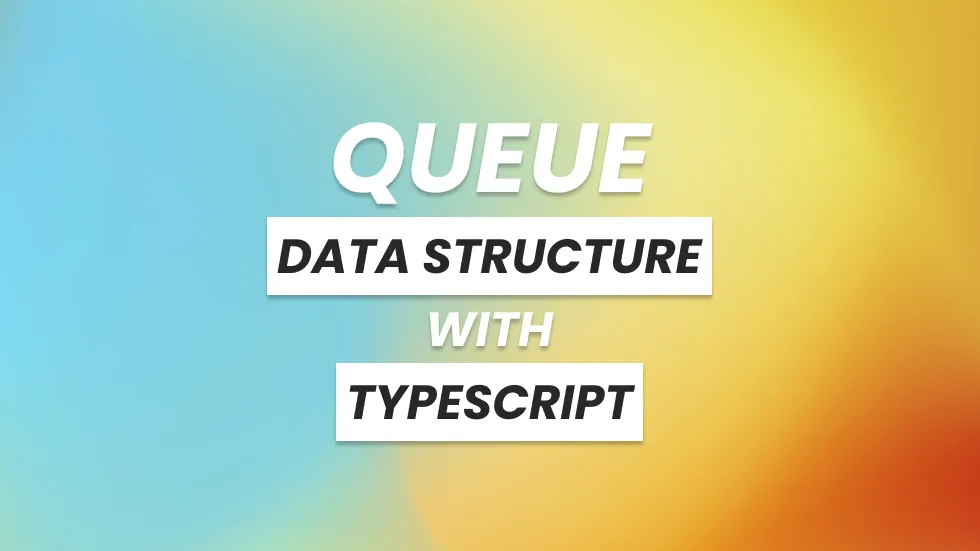
Data structures with TypeScript - Queue
In this chapter of Learning Data Structures with Typescript, we will be implementing and testing the Queue data structure.
What is a Queue?
A queue is a linear data structure that follows the order of First In First Out(FIFO). This means the first inserted element will be removed first. You can think of the queue as a line of people waiting to purchase movie tickets at a cinema theater.

Use cases of Queue data structure.
The queue can be useful in a situation where the order of the data inserted is important. Following are some common scenarios where queues can be useful.
- Handling website traffic
- Maintaining the playlist in media players
- Managing requests on a single shared resource
Basic operations of a Queue
A queue should be able to perform the following basic operations.
- Enqueue: Add an element to the end of the queue
- Dequeue: Remove an element from the front of the queue
- IsEmpty: Check if the queue is empty
- IsFull: Check if the queue is full
- Peek: Get the value of the first element without removing it

Implementation
In order to implement the Queue data structure, we can follow the following steps.
- Define 2 variables called
FRONTandREARto keep track of the first and last element of the queue - When initialized, set the value of
FRONT,REARto-1. Later we can use this to check if the queue is empty or not. - Whenever an item is enqueued, increase the value of
REARby 1 and place the new element at the position pointed byREAR. If the queue is empty, increase the value ofFRONTby 1. Also, check if the queue is full before pushing a new element. - Whenever an item is dequeued, decrease the value of
REARby 1. Also, check if the queue is empty before dequeuing an element. When dequeuing the last element, set theFRONTback to 0.
Following is the TyepeScript implementation of the Queue data structure
class Queue<T> {
private _front: number
private _rear: number
private _capacity: number
private _queue: T[]
constructor(capacity: number) {
this._front = -1
this._rear = -1
this._capacity = capacity
this._queue = [] as T[]
}
get queue() {
return this._queue
}
isFull(): boolean {
return this._front === 0 && this._rear === this._capacity - 1
}
isEmpty(): boolean {
return this._front === -1
}
enqueue(item: T): boolean {
if (this.isFull()) {
console.log('Failed: Maximum capacity reached')
return false
}
if (this._front === -1) {
this._front = 0
}
this._rear++
this._queue.push(item)
return true
}
dequeue(): boolean {
if (this.isEmpty()) {
console.log('Failed: Queue is already empty')
return false
}
this._queue.shift()
if (this._front === this._rear) {
this._front = -1
this._rear = -1
} else {
this._rear--
}
return true
}
peek() {
if (this.isEmpty()) {
console.log('Failed: Queue is empty')
return false
}
return this._queue[this._front]
}
}Testing
Now that we have implemented the Queue data structure using TypeScript, it is time to test the functionalities of our Queue. We will be using Jest to test them.
describe('test queue functionality', () => {
it('should be empty when initialized', () => {
const queue = new Queue(10)
const isEmpty = queue.isEmpty()
expect(isEmpty).toBe(true)
})
it('should be full when max capacity is reached', () => {
const queue = new Queue<string>(2)
queue.enqueue('🐅')
queue.enqueue('🐐')
const isFull = queue.isFull()
expect(isFull).toBe(true)
})
it('should add items to the queue', () => {
const queue = new Queue<number>(3)
queue.enqueue(2)
queue.enqueue(3)
expect(queue.queue).toStrictEqual([2, 3])
})
it('should remove items from the queue', () => {
const queue = new Queue<string>(5)
queue.enqueue('a')
queue.enqueue('b')
queue.enqueue('c')
queue.enqueue('d')
queue.enqueue('e')
queue.dequeue()
queue.dequeue()
expect(queue.queue).toStrictEqual(['c', 'd', 'e'])
})
it('should not allow to add more item than the capacity', () => {
const queue = new Queue<number>(1)
queue.enqueue(2)
const status = queue.enqueue(3)
expect(status).toBe(false)
})
it('should not allow to remove item when the queue is empty', () => {
const queue = new Queue<number>(1)
const status = queue.dequeue()
expect(status).toBe(false)
})
it('should return the first element', () => {
const queue = new Queue<string>(3)
queue.enqueue('hello')
queue.enqueue('world')
queue.enqueue('people')
const firstElement = queue.peek()
expect(firstElement).toBe('hello')
})
})